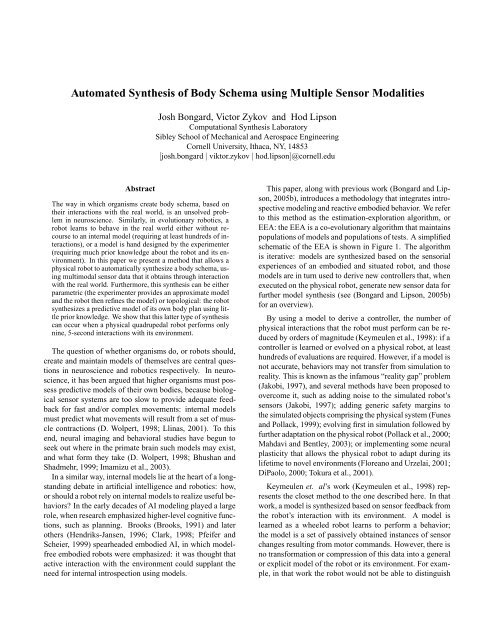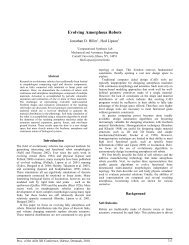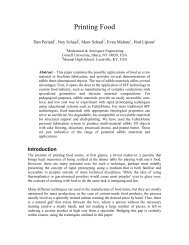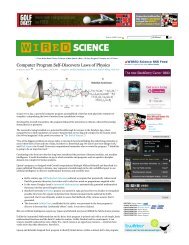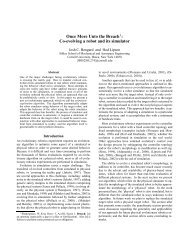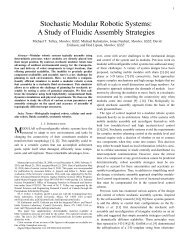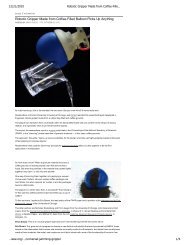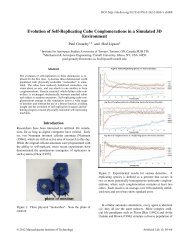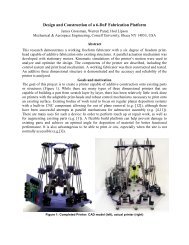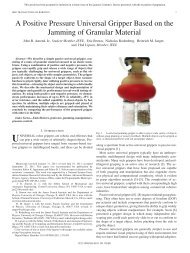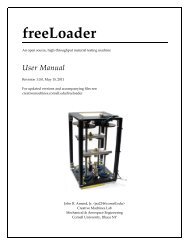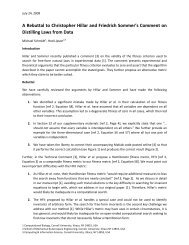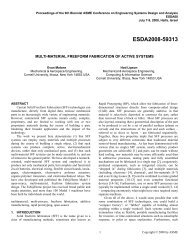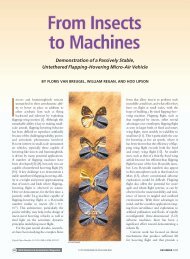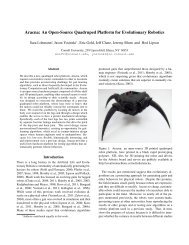Automated Synthesis of Body Schema using Multiple Sensor ...
Automated Synthesis of Body Schema using Multiple Sensor ...
Automated Synthesis of Body Schema using Multiple Sensor ...
Create successful ePaper yourself
Turn your PDF publications into a flip-book with our unique Google optimized e-Paper software.
<strong>Automated</strong> <strong>Synthesis</strong> <strong>of</strong> <strong>Body</strong> <strong>Schema</strong> <strong>using</strong> <strong>Multiple</strong> <strong>Sensor</strong> Modalities<br />
Abstract<br />
The way in which organisms create body schema, based on<br />
their interactions with the real world, is an unsolved problem<br />
in neuroscience. Similarly, in evolutionary robotics, a<br />
robot learns to behave in the real world either without recourse<br />
to an internal model (requiring at least hundreds <strong>of</strong> interactions),<br />
or a model is hand designed by the experimenter<br />
(requiring much prior knowledge about the robot and its environment).<br />
In this paper we present a method that allows a<br />
physical robot to automatically synthesize a body schema, <strong>using</strong><br />
multimodal sensor data that it obtains through interaction<br />
with the real world. Furthermore, this synthesis can be either<br />
parametric (the experimenter provides an approximate model<br />
and the robot then refines the model) or topological: the robot<br />
synthesizes a predictive model <strong>of</strong> its own body plan <strong>using</strong> little<br />
prior knowledge. We show that this latter type <strong>of</strong> synthesis<br />
can occur when a physical quadrupedal robot performs only<br />
nine, 5-second interactions with its environment.<br />
The question <strong>of</strong> whether organisms do, or robots should,<br />
create and maintain models <strong>of</strong> themselves are central questions<br />
in neuroscience and robotics respectively. In neuroscience,<br />
it has been argued that higher organisms must possess<br />
predictive models <strong>of</strong> their own bodies, because biological<br />
sensor systems are too slow to provide adequate feedback<br />
for fast and/or complex movements: internal models<br />
must predict what movements will result from a set <strong>of</strong> muscle<br />
contractions (D. Wolpert, 1998; Llinas, 2001). To this<br />
end, neural imaging and behavioral studies have begun to<br />
seek out where in the primate brain such models may exist,<br />
and what form they take (D. Wolpert, 1998; Bhushan and<br />
Shadmehr, 1999; Imamizu et al., 2003).<br />
In a similar way, internal models lie at the heart <strong>of</strong> a longstanding<br />
debate in artificial intelligence and robotics: how,<br />
or should a robot rely on internal models to realize useful behaviors?<br />
In the early decades <strong>of</strong> AI modeling played a large<br />
role, when research emphasized higher-level cognitive functions,<br />
such as planning. Brooks (Brooks, 1991) and later<br />
others (Hendriks-Jansen, 1996; Clark, 1998; Pfeifer and<br />
Scheier, 1999) spearheaded embodied AI, in which modelfree<br />
embodied robots were emphasized: it was thought that<br />
active interaction with the environment could supplant the<br />
need for internal introspection <strong>using</strong> models.<br />
Josh Bongard, Victor Zykov and Hod Lipson<br />
Computational <strong>Synthesis</strong> Laboratory<br />
Sibley School <strong>of</strong> Mechanical and Aerospace Engineering<br />
Cornell University, Ithaca, NY, 14853<br />
[josh.bongard | viktor.zykov | hod.lipson]@cornell.edu<br />
This paper, along with previous work (Bongard and Lipson,<br />
2005b), introduces a methodology that integrates introspective<br />
modeling and reactive embodied behavior. We refer<br />
to this method as the estimation-exploration algorithm, or<br />
EEA: the EEA is a co-evolutionary algorithm that maintains<br />
populations <strong>of</strong> models and populations <strong>of</strong> tests. A simplified<br />
schematic <strong>of</strong> the EEA is shown in Figure 1. The algorithm<br />
is iterative: models are synthesized based on the sensorial<br />
experiences <strong>of</strong> an embodied and situated robot, and those<br />
models are in turn used to derive new controllers that, when<br />
executed on the physical robot, generate new sensor data for<br />
further model synthesis (see (Bongard and Lipson, 2005b)<br />
for an overview).<br />
By <strong>using</strong> a model to derive a controller, the number <strong>of</strong><br />
physical interactions that the robot must perform can be reduced<br />
by orders <strong>of</strong> magnitude (Keymeulen et al., 1998): if a<br />
controller is learned or evolved on a physical robot, at least<br />
hundreds <strong>of</strong> evaluations are required. However, if a model is<br />
not accurate, behaviors may not transfer from simulation to<br />
reality. This is known as the infamous “reality gap” problem<br />
(Jakobi, 1997), and several methods have been proposed to<br />
overcome it, such as adding noise to the simulated robot’s<br />
sensors (Jakobi, 1997); adding generic safety margins to<br />
the simulated objects comprising the physical system (Funes<br />
and Pollack, 1999); evolving first in simulation followed by<br />
further adaptation on the physical robot (Pollack et al., 2000;<br />
Mahdavi and Bentley, 2003); or implementing some neural<br />
plasticity that allows the physical robot to adapt during its<br />
lifetime to novel environments (Floreano and Urzelai, 2001;<br />
DiPaolo, 2000; Tokura et al., 2001).<br />
Keymeulen et. al’s work (Keymeulen et al., 1998) represents<br />
the closet method to the one described here. In that<br />
work, a model is synthesized based on sensor feedback from<br />
the robot’s interaction with its environment. A model is<br />
learned as a wheeled robot learns to perform a behavior;<br />
the model is a set <strong>of</strong> passively obtained instances <strong>of</strong> sensor<br />
changes resulting from motor commands. However, there is<br />
no transformation or compression <strong>of</strong> this data into a general<br />
or explicit model <strong>of</strong> the robot or its environment. For example,<br />
in that work the robot would not be able to distinguish
a<br />
b<br />
Figure 1: The physical robot targeted for automated identification.<br />
between its left and right wheels, because it has no explicit<br />
model <strong>of</strong> its own body; it can only predict, in environmental<br />
contexts that it has already encountered, what might happen<br />
if it sends a motor command to its wheel. In contrast, the<br />
EEA actively generates explicit models based on incoming<br />
sensor data (such as shown in Figure 5). Here, we present<br />
validation <strong>of</strong> our algorithm on a physical articulated robot<br />
(shown in Figure 1a): the robot evolves an explicit model <strong>of</strong><br />
its body <strong>using</strong> sensor data from different modalities. This<br />
is the first time explicit, predictive robot models have been<br />
intelligently synthesized based on physical interactions.<br />
In the next section the methodology is described, which<br />
includes description <strong>of</strong> the target robot, the space <strong>of</strong> models<br />
and the space <strong>of</strong> controllers, and how these spaces are<br />
searched. Then, results from both parametric and topological<br />
identification <strong>of</strong> the robot are presented; the final section<br />
provides some discussion and concluding remarks.<br />
Methods<br />
In previous work we have documented the ability <strong>of</strong> the EEA<br />
to parametrically identify a simulated target robot, given<br />
some initial approximate model <strong>of</strong> it (Bongard and Lipson,<br />
2005b). In other problem domains we have demonstrated<br />
that the EEA can synthesize both the topology and param-<br />
eters <strong>of</strong> a hidden system, in which no model is required a<br />
priori (Bongard and Lipson, 2005a). In order to apply the<br />
EEA to a new target system, such as the physical robot used<br />
in this work, three preparatory steps must be first carried out:<br />
characterization <strong>of</strong> the system to be identified, how models<br />
are to be represented and optimized, and how controllers are<br />
to be represented and optimized.<br />
Characterizing the Target System<br />
The target system in this study is a quadrupedal, articulated<br />
robot with eight actuated degrees <strong>of</strong> freedom. The robot consists<br />
<strong>of</strong> a rectangular body and four legs attached to it with<br />
hinge joints on each <strong>of</strong> the four sides <strong>of</strong> the robot’s body.<br />
Each leg in turn is composed <strong>of</strong> an upper and lower leg, attached<br />
together with a hinge joint. All eight hinge joints<br />
<strong>of</strong> the robot are actuated with Airtronics 94359 high torque<br />
servomotors. However, in the current study, the robot was<br />
simplified by assuming that the knee joints are frozen: all<br />
four legs are held straight when the robot is commanded to<br />
perform some action. Table 1 gives the overall dimensions<br />
<strong>of</strong> the robot’s parts.<br />
Parameter Value (mm)<br />
Width and length <strong>of</strong> the body 140<br />
Height <strong>of</strong> the body 85<br />
Length <strong>of</strong> the upper leg 95<br />
Height <strong>of</strong> the upper leg 26<br />
Length <strong>of</strong> the lower leg 125<br />
Diameter <strong>of</strong> the foot 12<br />
Table 1: Physical dimensions <strong>of</strong> the robot.<br />
All eight servomotors are controlled <strong>using</strong> an on-board<br />
PC-104 computer via a serial servo control board SV-203B,<br />
which converts serial commands into pulse-width modulated<br />
signals. Servo drives are capable <strong>of</strong> producing a maximum<br />
<strong>of</strong> 200 ounce-inches <strong>of</strong> torque and 60 degrees per second <strong>of</strong><br />
speed. The actuation ranges for all <strong>of</strong> the robot’s joints are<br />
summarized in table 2.<br />
Lower range bound Upper range bound<br />
(degrees) (degrees)<br />
Hip joint -96 +74<br />
Knee joint -96 +94<br />
Table 2: Joint properties <strong>of</strong> the robot. Ranges are given relative<br />
to the robot body for the hip joints, and relative to the<br />
upper legs for the knee joints. Positive numbers indicate upward<br />
motion; negative values indicate downward motion.<br />
The robot is equipped with a suite <strong>of</strong> different sensors<br />
polled by a 16-bit 32- channel PC-104 Diamond MM-32X-<br />
AT data acquisition board. For the current identification<br />
task, three sensor modalities were used: an external sensor<br />
was used to determine the left/right and forward/back
tilt <strong>of</strong> the robot; four binary values indicated whether a foot<br />
was touching the ground or not; and one value indicated the<br />
clearance distance from the robot’s underbelly to the ground,<br />
along the normal to its lower body surface. All sensor readings<br />
were conducted manually, however all three kinds <strong>of</strong><br />
signals will be recorded in future by on-board accelerometers,<br />
the strain gauges built into the lower legs, and an optical<br />
distance sensor placed on the robot’s belly.<br />
Characterizing the Space <strong>of</strong> Models<br />
Models are considered to be three-dimensional simulations<br />
<strong>of</strong> the physical robot (see Figure 5 for three model examples).<br />
The simulations are created within Open Dynamics<br />
Engine 1 , a three-dimensional dynamics simulator. However<br />
in the current work only static identification is performed:<br />
the physical robot is commanded to achieve a static pose,<br />
and then hold still while sensor data is taken. Every candidate<br />
model (as well as the target robot) is assumed to start<br />
as a planar configuration <strong>of</strong> parts; when it begins to move, it<br />
can assume a three-dimensional configuration. The geometry<br />
and physical properties <strong>of</strong> the main body part is assumed<br />
to be known; the eight upper and lower leg parts are represented<br />
as solid cylinders. Each model is evaluated for an<br />
arbitrarily set time <strong>of</strong> 300 time steps <strong>of</strong> the simulator, which<br />
is enough time for most models to come to rest given an<br />
arbitrary motor program.<br />
Models are encoded as either vectors or matrices, and<br />
these data structures are used to construct a possible articulated<br />
robot in the simulation environment. In the first set<br />
<strong>of</strong> experiments, we assume that everything about the physical<br />
robot is known except the lengths <strong>of</strong> its four legs. Models<br />
are therefore encoded as vectors containing eight real-valued<br />
parameters in [0,1], with each value encoding the estimated<br />
length <strong>of</strong> one <strong>of</strong> the eight leg parts. We constrain the estimation<br />
about the minimum and maximum length <strong>of</strong> a leg to<br />
be between 2 and 40 centimeters, so each value is scaled to<br />
a real-value in [1,20]cm.<br />
In the second set <strong>of</strong> results, we assume that less information<br />
about the robot is known: how the eight body parts attach<br />
to each other or the main body, and how the hinge joints<br />
connecting them are oriented. In that case, models are encoded<br />
as 8 × 4 real-valued matrices. Each row corresponds<br />
to one <strong>of</strong> the eight parts. The first value in row i is scaled to<br />
an integer in [0,i−1], indicating which <strong>of</strong> the previous body<br />
parts it attaches to; the second value is scaled to an integer in<br />
[0,3], indicating whether the current part attaches to the left,<br />
front, right, or back side <strong>of</strong> the parental part. The third value<br />
is scaled to an integer in [0,5], and indicates how the hinge<br />
joint connecting the current part to its parent operates: 0 and<br />
1 cause the part to rotate leftward or rightward in response<br />
to a positive commanded joint angle (and rightward and leftward<br />
in response to a negative commanded angle); 2 and 3<br />
1 http://ode.org<br />
cause the joint to rotate upward or downward in response to<br />
a positive commanded angle; and 4 and 5 cause the part to<br />
rotate leftward or rightward around its own axis in response<br />
to a positive commanded angle. The fourth value is scaled<br />
to a value in [1,20]cm to represent the length <strong>of</strong> the leg part.<br />
In both types <strong>of</strong> experiments, a genetic algorithm <strong>using</strong><br />
deterministic crowding (Mahfoud, 1995) is used to optimize<br />
the models. Genomes in the population are simply the vectors<br />
or matrices described above. The subjective error <strong>of</strong> encoded<br />
models is minimized by the genetic algorithm. Subjective<br />
error is given as the error between the sensor values<br />
obtained from the physical robot, and those obtained from<br />
the simulated one:<br />
e = v +<br />
4<br />
i=1<br />
|t (t)<br />
i − m(t) i | +<br />
2<br />
j=1<br />
|t (l)<br />
j − m(l) j | + 10|t(c) − m (c) |,<br />
where e is the error <strong>of</strong> the model; v indicates the linear velocity<br />
<strong>of</strong> the model robot (sometimes models do not come to<br />
rest); t (t)<br />
i indicates whether leg i touched the ground for the<br />
target robot; m (t)<br />
i indicates whether leg i touched the ground<br />
for the model robot; t (l)<br />
j indicates how much (in degrees) the<br />
main body <strong>of</strong> the target robot was tilted away in relation to<br />
gravity ( j = 1 for left/right tilt; j = 2 for forward/back tilt);<br />
m (l)<br />
j indicates how much the main body <strong>of</strong> the model was<br />
tilted; t (c) indicates the clearance (in meters) from the target<br />
robot’s belly to the ground; and m (c) indicates the clearance<br />
for the model robot. By minimizing v, we select models that<br />
come to rest within the alloted time. The clearance sensor<br />
difference is amplified because it is reported in meters, and<br />
for most poses achieved by the physical robot this value is<br />
very small compared to the other terms. As can be seen in<br />
Figure 1b, after the second set <strong>of</strong> sensor data has been obtained<br />
from the target robot, there are two (or more) sets <strong>of</strong><br />
sensor data to be matched by a given model; in this case, the<br />
subjective error <strong>of</strong> a model becomes<br />
e = max{e1,e2,...en},<br />
where ek indicates the error <strong>of</strong> the model <strong>using</strong> motor program<br />
and sensor data set k from the physical robot.<br />
In the first pass through the estimation phase, a random<br />
population <strong>of</strong> models is generated, and optimized for<br />
a fixed number <strong>of</strong> generations. On the second and subsequent<br />
passes through the estimation phase, the previously<br />
optimized population <strong>of</strong> models is used as the starting point,<br />
but they are re-evaluated according to the new error metric<br />
with the additional set <strong>of</strong> sensor data.<br />
Characterizing the Space <strong>of</strong> Controllers<br />
In this work a motor program is a set <strong>of</strong> four joint angles that<br />
either the target robot, or a model robot, is commanded to<br />
achieve 2 . Both the target and model robots begin in a planar<br />
2 The four elbow joints are locked for these experiments.
a<br />
b<br />
c<br />
d<br />
Subjective Error<br />
Total Length <strong>of</strong> Leg (cm)<br />
Subjective Error<br />
Total Length <strong>of</strong> Leg (cm)<br />
40<br />
30<br />
20<br />
10<br />
8<br />
6<br />
4<br />
3<br />
2<br />
0<br />
40<br />
10 20<br />
Generation<br />
30 40<br />
35<br />
30<br />
25<br />
20<br />
15<br />
10<br />
5<br />
40<br />
30<br />
20<br />
10<br />
8<br />
6<br />
0 10 20 30 40<br />
Generation<br />
4<br />
3<br />
2<br />
0<br />
40<br />
10 20<br />
Generation<br />
30 40<br />
35<br />
30<br />
25<br />
20<br />
15<br />
10<br />
5<br />
0 10 20 30 40<br />
Generation<br />
Figure 2: Results from two runs <strong>of</strong> parametric identification.<br />
a: The subjective error <strong>of</strong> each model. Model error<br />
is calculated <strong>using</strong> touch, tilt and clearance sensor data. b:<br />
The estimated leg lengths from the best model after each<br />
generation from the same run. (Dots=target leg length; left<br />
arrow=left leg, right arrow=right leg, up arrow=forward leg,<br />
and down arrow=back leg.) c: The subjective error <strong>of</strong> each<br />
model from another run in which only touch and tilt sensor<br />
data is used. d: The estimated leg lengths from the best<br />
model after each generation from this run. Vertical lines indicate<br />
the end <strong>of</strong> an iteration; a new pose is introduced in the<br />
following generation.<br />
configuration, with the joint angles at zero. Joint angles in a<br />
given motor program are selected randomly from the range<br />
[−30,30] degrees. This constrains the range <strong>of</strong> motion <strong>of</strong><br />
the target robot; without a model <strong>of</strong> itself, it is possible that<br />
the robot could perform some action that would be harmful<br />
to itself or complicate the inference process.<br />
At the beginning <strong>of</strong> an identification run, a random motor<br />
program is generated, and sent to the target robot. Its motors<br />
are sufficiently strong to reach the desired angles. Once<br />
it reaches those angles it holds steady, and the sensor data<br />
is taken, and fed into the EEA. The estimation phase then<br />
begins, as outlined above. When the estimation phase terminates,<br />
a new random motor program is generated. For this<br />
work, the exploration phase is not used; i.e., a useful motor<br />
program is not sought. Thus, the search for controllers is<br />
random.<br />
Results: Parametric Identification<br />
In the first set <strong>of</strong> experiments, only the lengths <strong>of</strong> the eight<br />
leg parts were identified: all other aspects <strong>of</strong> the target robot<br />
are assumed to be known. In the estimation phase, a population<br />
<strong>of</strong> 100 random models are created, and in each pass<br />
the population is evolved for 10 generations. A total <strong>of</strong> four<br />
random motor programs are used; the population <strong>of</strong> models<br />
is optimized four times, each time with an additional motor<br />
program and resulting set <strong>of</strong> sensor data from the target<br />
robot.<br />
In total, 30 independent runs were conducted for each <strong>of</strong><br />
seven experimental variants. In each variant, three or less<br />
<strong>of</strong> the sensor modalities are assumed to be available during<br />
model optimization. Figure 2 reports results from a typical<br />
run from two variants. In the first run, all three sensor<br />
modalities—touch, tilt and clearance—were assumed available<br />
for identification. In the second run, only touch and tilt<br />
information were available. As can be seen, the first run was<br />
more successful than the second: there is significant error on<br />
the estimation <strong>of</strong> the length <strong>of</strong> the left leg when only touch<br />
and tilt information are used.<br />
Figure 3 generalizes this finding. The average quality <strong>of</strong><br />
the optimized models are compared across the seven variants.<br />
As can be seen in figure 3a, only the tilt sensor data<br />
is required in order to produce good models, where model<br />
quality is determined as the mean difference between the<br />
length <strong>of</strong> the model’s leg and the target robot’s leg. This is<br />
because for the experiment variants that included tilt information<br />
in calculating model quality (columns 1, 2, 4 and 6),<br />
evolved models were more accurate than when tilt information<br />
was excluded from the calculation (columns 3, 5 and<br />
7). Figure 3b reports data from the same set <strong>of</strong> runs, but<br />
now model quality is determined as the variance across the<br />
lengths <strong>of</strong> a single model’s legs; in a good model all four<br />
legs should have the same length. As can be seen, when<br />
both tilt and clearance sensor data is available (columns 1<br />
and 2), models are better than when either <strong>of</strong> these sensor
a<br />
b<br />
Objective Error (cm)<br />
Objective Error (cm)<br />
14<br />
12<br />
10<br />
8<br />
6<br />
4<br />
2<br />
0<br />
30<br />
25<br />
20<br />
15<br />
10<br />
5<br />
0<br />
Mean Error from Target Leg Length<br />
1 2 3 4<br />
Estimation Phase Pass<br />
Difference Between Longest and Shortest Leg<br />
1 2 3 4<br />
Estimation Phase Pass<br />
Figure 3: Model quality versus available sensor data.<br />
a: The mean differences between an evolved model’s leg<br />
lengths and the target leg lengths, compared across seven<br />
experimental variants. The variants within a grouping are,<br />
from left to right: touch, tilt, and clearance available; tilt and<br />
clearance; touch and clearance; touch and tilt; only touch;<br />
only tilt; and only clearance. In each variants, each <strong>of</strong> the<br />
three sensor modalities (touch, tilt and clearance) was or<br />
was not available for estimating model quality. The reported<br />
means were averaged over the 30 best models obtained at<br />
the end <strong>of</strong> each <strong>of</strong> the four estimation iterations. Error bars<br />
indicate one unit <strong>of</strong> standard deviation. b: The same models<br />
were evaluated <strong>using</strong> a different metric: the difference<br />
between the longest and shortest leg.<br />
modalities is not available (columns 3-7).<br />
Results: Topological Identification<br />
In the second set <strong>of</strong> experiments, the inference algorithm<br />
was required not only to identify the length <strong>of</strong> the robot’s<br />
legs, but how the legs are attached to one another or to<br />
the main body, and where they are attached. In these experiments,<br />
parametric changes in the genome correspond to<br />
a<br />
b<br />
c<br />
Subjective Error<br />
Total Length <strong>of</strong> Leg (cm)<br />
40<br />
30<br />
20<br />
10<br />
8<br />
6<br />
4<br />
3<br />
2<br />
40<br />
35<br />
30<br />
25<br />
20<br />
15<br />
10<br />
5<br />
Back Leg<br />
Right Leg<br />
Forward Leg<br />
Left Leg<br />
40 80 120 160 200 240 280 320<br />
Generation<br />
40 80 120 160 200 240 280 320<br />
Generation<br />
1 2 3 4 5 6 7 8 9<br />
Best Model from Iteration<br />
Figure 4: Results from a successful topological identification.<br />
a: The subjective errors <strong>of</strong> all models. b: The<br />
estimated leg lengths <strong>of</strong> the best models from each generation.<br />
c: The estimated local topological configurations for<br />
the best model produced by each estimation iteration. A<br />
filled square indicates the correct configuration was found;<br />
a white square indicates it was not. P=parental body part to<br />
which the body part attaches; O=orientation <strong>of</strong> the body part<br />
relative to its parent; J=joint normal.<br />
topological changes in the body plan <strong>of</strong> the robot model. In<br />
this more difficult task, the population size was expanded to<br />
300, and each pass through the estimation phase was con-<br />
J<br />
O<br />
P<br />
J<br />
O<br />
P<br />
J<br />
O<br />
P<br />
J<br />
O<br />
P
a<br />
b<br />
c<br />
d<br />
Figure 5: Results from a successful topological identification.<br />
a: The pose produced by the physical robot as a result<br />
<strong>of</strong> running the first random motor program. b: The best<br />
model produced after the first iteration <strong>of</strong> the run reported<br />
in figure 4. c: The best model after the fifth iteration. d:<br />
The best model after the ninth iteration. The physical robot<br />
and the three models are shown performing the same motor<br />
program.<br />
ducted for 40 generations.<br />
Figure 4 reports the behavior <strong>of</strong> the single successful run<br />
achieved so far (a total <strong>of</strong> 10 runs have been performed).<br />
Figures 4b and 4c report the leg lengths and local topological<br />
configurations (which parental part to attach to, where<br />
to attach to it, and with which joint orientation) <strong>of</strong> the best<br />
models. As can be seen, all 12 configurations are successfully<br />
discovered partway through the eighth identification iteration,<br />
after which the leg lengths converge relatively close<br />
Back Leg<br />
Right Leg<br />
Forward Leg<br />
Left Leg<br />
1 2 3 4 5 6 7 8 9 10<br />
Best Model from Run<br />
Figure 6: The relative successes <strong>of</strong> the 10 runs for topological<br />
identification. Each column indicates how many <strong>of</strong><br />
the 12 local configurations the best model from each run got<br />
right (black=correct; white=incorrect).<br />
to the correct length. Figures 5b-d show the best model obtained<br />
at the end <strong>of</strong> the first, fifth and ninth iteration, respectively.<br />
Figure 5 shows that the final model is indeed a predictive<br />
model: given the same motor program (such as the<br />
first random motor program), both the model and the physical<br />
robot achieve similar poses (compare Figures 5a and d).<br />
However, Figure 6 indicates that this is a difficult task: constrained<br />
to nine identification iterations, only one <strong>of</strong> the 10<br />
independent runs performed found all 12 <strong>of</strong> the correct local<br />
configurations.<br />
Conclusions<br />
Here we have reported the successful automated synthesis<br />
<strong>of</strong> robot models based on a physical robot’s embodied and<br />
situated interactions with its environment. Specifically, we<br />
have demonstrated successful parametric identification, in<br />
which an approximate model was parametrically optimized,<br />
and topological identification, in which a model was built<br />
up by combining disparate model building blocks (in this<br />
work, leg parts) together in the right way, and at the same<br />
time optimizing the parameters <strong>of</strong> those building blocks (leg<br />
part lengths). In the case <strong>of</strong> parametric identification, it was<br />
demonstrated that the method automatically integrates information<br />
from different sensor modalities: neither the tilt<br />
nor clearance sensor data explicitly report the length <strong>of</strong> the<br />
robot’s legs, but both modalities are required by the model<br />
synthesis process to produce accurate models. It has been<br />
argued in the neuroscience literature that multimodal sensor<br />
data is necessary for building body schema (Maravita<br />
et al., 2003), and in robotic studies it has been shown how<br />
body schema may be created by finding correlations in sig-<br />
J<br />
O<br />
P<br />
J<br />
O<br />
P<br />
J<br />
O<br />
P<br />
J<br />
O<br />
P
nals across sensor modalities (Lungarella and Pfeifer, 2001;<br />
Hafner and Kaplan, 2005).<br />
This methodology presents a unified framework for studying<br />
how internal models can be qualitatively synthesized,<br />
parametrically optimized, and dynamically changed as a<br />
robot actively explores its environment. In future work we<br />
intend to investigate what kind <strong>of</strong> model is appropriate for<br />
a given robot and task (i.e. explicit versus neural networkbased<br />
models), and how the models can be used to create<br />
new controllers. Controllers can be synthesized by the robot<br />
to learn more about itself and its local environment or to generate<br />
new behaviors on the fly in response to unanticipated<br />
morphological change (damage or tool use), environmental<br />
change, or change in the desired task. This method may also<br />
help generate testable hypotheses about how higher animals<br />
create models <strong>of</strong> themselves and use them to guide behavior.<br />
References<br />
Bhushan, N. and Shadmehr, R. (1999). Computational<br />
nature <strong>of</strong> human adaptive control during learning <strong>of</strong><br />
reaching movements in force fields. Biological Cybernetics,<br />
81:39–60.<br />
Bongard, J. and Lipson, H. (2005a). Active coevolutionary<br />
learning <strong>of</strong> deterministic finite automata. Journal <strong>of</strong><br />
Machine Learning Research, 6(Oct):1651–1678.<br />
Bongard, J. and Lipson, H. (2005b). Nonlinear system identification<br />
<strong>using</strong> coevolution <strong>of</strong> models and tests. IEEE<br />
Transactions on Evolutionary Computation, 9(4):361–<br />
384.<br />
Brooks, R. A. (1991). Intelligence without representation.<br />
Artificial Intelligence, 47:139–160.<br />
Clark, A. (1998). Being There: Putting Brain, <strong>Body</strong>, and<br />
World Together Again. Bradford Books, Cambridge,<br />
MA.<br />
D. Wolpert, R. C. Miall, M. K. (1998). Internal models <strong>of</strong><br />
the cerebellum. Trends in Cognitive Sciences, 2:2381–<br />
2395.<br />
DiPaolo, E. A. (2000). Homeostatic adaptation to inversion<br />
<strong>of</strong> the visual field and other sensorimotor disruptions.<br />
In Meyer, J. A., Berthoz, A., Floreano, D., Roitblat,<br />
H. L., and Wilson, S. W., editors, From Animals to Animats<br />
6, pages 440–449. MIT Press.<br />
Floreano, D. and Urzelai, J. (2001). Neural morphogenesis,<br />
synaptic plasticity, and evolution. Theory in Bioscience,<br />
120:225–240.<br />
Funes, P. and Pollack, J. (1999). Computer evolution <strong>of</strong><br />
buildable objects. In Bentley, P., editor, Evolutionary<br />
Design by Computer, pages 387–403. Morgan Kauffman,<br />
San Francisco.<br />
Hafner, V. and Kaplan, F. (2005). Interpersonal maps and the<br />
body correspondence problem. In Proceedings <strong>of</strong> the<br />
AISB 2005 Third International Symposium on Imitation<br />
in Animals and Artifacts, pages 48–53, Hatfield, UK.<br />
Hendriks-Jansen, H. (1996). Catching Ourselves in the<br />
Act: Situated Activity, Interactive Emergence, Evolution,<br />
and Human Thought. MIT Press, Boston, MA.<br />
Imamizu, H., Kuroda, T., Miyauchi, S., Yoshioka, T., and<br />
Kawato, M. (2003). Modular organization <strong>of</strong> internal<br />
models <strong>of</strong> tools in the human cerebellum. Proceedings<br />
<strong>of</strong> the National Academy <strong>of</strong> Sciences, 100(9):5461–<br />
5466.<br />
Jakobi, N. (1997). Evolutionary robotics and the radical<br />
envelope <strong>of</strong> noise hypothesis. Adaptive Behavior,<br />
6(1):131–174.<br />
Keymeulen, D., Iwata, M., Kuniyoshi, Y., and Higuchi, T.<br />
(1998). Online evolution for a self-adapting robotics<br />
navigation system <strong>using</strong> evolvable hardware. Artificial<br />
Life, 4:359–393.<br />
Llinas, R. R. (2001). The i <strong>of</strong> the Vortex. Cambridge, MA:<br />
MIT Press.<br />
Lungarella, M. and Pfeifer, R. (2001). Robots as cognitive<br />
tools: Information theoretic analysis <strong>of</strong> sensory-motor<br />
data. In IEEE-RAS Intl. Conf. on Humanoid Robotics,<br />
pages 245–252.<br />
Mahdavi, S. H. and Bentley, P. J. (2003). An evolutionary<br />
approach to damage recovery <strong>of</strong> robot motion with<br />
muscles. In Seventh European Conference on Artificial<br />
Life (ECAL03), pages 248–255. Springer.<br />
Mahfoud, S. W. (1995). Niching methods for genetic algorithms.<br />
PhD thesis, Urbana, IL, USA.<br />
Maravita, A., Spence, C., and Driver, J. (2003). Multisensory<br />
integration and the body schema: close to hand<br />
and within reach. Current Biology, 13(13):R531–R539.<br />
Pfeifer, R. and Scheier, C. (1999). Understanding Intelligence.<br />
MIT Press, Cambridge, MA.<br />
Pollack, J. B., Lipson, H., Ficici, S., Funes, P., Hornby,<br />
G., and Watson, R. (2000). Evolutionary techniques<br />
in physical robotics. In Miller, J., editor, Evolvable<br />
Systems: from biology to hardware, pages 175–186.<br />
Springer-Verlag.<br />
Tokura, S., Ishiguro, A., Kawai, H., and Eggenberger, P.<br />
(2001). The effect <strong>of</strong> neuromodulations on the adaptability<br />
<strong>of</strong> evolved neurocontrollers. In Kelemen, J. and<br />
Sosik, P., editors, Sixth European Conference on Artificial<br />
Life, pages 292–295.


